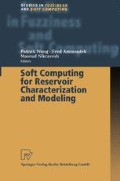Abstract
Reservoir characterization is usually a long and costly process. Engineers, geologists and geophysicists use many different methodologies to characterize the hydrocarbon reservoirs. The conventional reservoir characterization studies normally involve a series of data collection and interpretation processes that can be cost prohibitive. This chapter reviews a collection of methods developed by the author over several years in order to generate a better understanding of reservoir characteristics only using the available data. These methodologies were developed using artificial neural networks and dates back to early 1990s. In this collection of studies, the types of data used for reservoir characterization are wireline logs, core data, and magnetic resonance logs. The outcomes of the reservoir characterization studies using the tools being introduced here are effective porosity, fluid saturation and formation permeability. Based on the amount and the quality of the available data one or more of the aforementioned reservoir properties can be characterized.
Access this chapter
Tax calculation will be finalised at checkout
Purchases are for personal use only
Preview
Unable to display preview. Download preview PDF.
References
Mohaghegh, S., Goddard, C., Popa, A., Ameri, S., and Bhuiyan, M. 2000: “Reservoir Characterization Through Synthetic Logs”, SPE 65675, Proceedings, 2000 SPE Eastern Regional Conference and Exhibition, October 17–19, Morgantown, West Virginia.
Mohaghegh, S., Koperna, G., Popa, A. S. and Hill, D. G. 1999: “Reducing the Cost of FieldScale Log Analysis Using Virtual Intelligence Techniques”, SPE 57454, Proceedings, 1999 SPE Eastern Regional Conference and Exhibition, October 21–22, Charleston, West Virginia.
Archie, G. E.:“The Electrical Resistivity Log as an Aid in Determining Some Reservoir Characteristics,” Trans., AIMS, 1942, Vol.146, No. 1, pp. 54–62
Tixier, M.P.: “Evaluation of Permeability From Electric-Log Resistivity Gradients,” Oil & Gas Journal, (June 1949), pp. 113.
Wyllie, M.R.J. and Rose, W.D.: “Some Theoretical Considerations Related to the Quantitative Evaluation of the Physical Characteristics of Reservoir Rock from Electric Log Data,” Trans., AIME, Vol. 189, (1950), pp. 105.
Pirson, S.J.: “Handbook of Well Log Analysis,” Englewood Cliffs, N.J., Prentice-Hall, Inc., (1963).
Timur, A.: “An Investigation of Permeability, Porosity, and Residual Water Saturation Relationship for Sandstone Reservoirs,” The Log Analyst, Vol. 9, No. 4, (July-August 1968), pp. 8.
Coats, G.R. and Dumanoir, J.L.: “A New Approach to Improved Log-Derived Permeability,” The Log Analyst, (January-February 1974), pp. 17.
Schlumberger Ltd.: “Log Interpretation Charts,” Houston, Texas, (1987).
Kapadia, S.P. and Menzie, U.: “Determination of Permeability Variation Factor V From Log Analysis,” SPE 14402, Annual Technical Conference, Las Vegas, NV, (September 1985).
Bloch, S.: “Empirical Prediction of Porosity and Permeability in Sandstones,” AAPG Bulletin, Vol. 75, No. 7, (July 1991), pp. 1145.
Ahmed, U., Crary, S.F., Coates, G.R.: “Permeability Estimation: The Various Sources and Their Interrelationships,” JPT, (May 1991), pp. 578.
Wendt, W.A., Sakurai, S., Nelson, P.H.: “Permeability Prediction From Well Logs Using Multiple Regression,” in Lake, L.W. and Caroll, H.B.,Jr..,editors: “Reservoir Characterization,” Academic Press, New York, (1986).
Draper, N.R., Smith, H.: “Applied Regression Analysis,” Wiley, (1981).
Dubrule, O., Haldorsen, H.H.: “Geostatistics for Permeability Estimation,” in Lake, L.W. and Caroll, H.B.,Jr.,editors: “Reservoir Characterization,” Academic Press, New York, (1986).
Osborne, D.A.: “Permeability Estimation Using a Neural Network: A Case Study from The Roberts Unit, Wasson Field, Yoakum County, Texas,” AAPG South West Section Transactions, 1992, pp. 125–132.
Mohaghegh, S., Reza, A., Ameri, S., Rose, D.: “Design and Development of An Artificial Neural Network for Estimation of Formation Permeability,” SPE 28237, SPE Petroleum Computer Conference, Dallas, Texas,(August 1994).
Balan, B., Mohaghegh, S., and Ameri, S., “State-of-the-art in Permeability Determination From Well Log Data, Part 1: A Comparative Study, Model Development,” SPE 30978, Proceedings, SPE Eastern Regional Conference and Exhibition, September 1921, 1995, Morgantown, WV.
Mohaghegh, S., Balan, B., and Ameri, S., “State-of-the-art in Permeability Determination From Well Log Data, Part 2: Verifiable, Accurate Permeability Predictions, the Touch Stone of All Models,” SPE 30979, Proceedings, SPE Eastern Regional Conference and Exhibition, September 19–21, 1995, Morgantown, West Virginia.
Mohaghegh, S., Balan, B., and Ameri, S.:“Determination of Permeability From Well Log Data.” SPE Formation Evaluation Journal, September 1997, pp 170–174.
Mohaghegh, S., Arefi, G., and Ameri, S.:“Virtual Measurement of Heterogeneous Formation Permeability Using Geophysical Well Log Responses.” The Log Analyst, A Journal of Formation Evaluation and Reservoir Description, Society of Professional Well Log Analysts, March-April, 1996, pp 32–39.
Doveton, J. H.: “Geological Log Analysis Using Computer Methods,” AAPG Computer Applications in Geology, 1994, No. 2, AAPG, Tulsa, 169 pp.
Aminian, K.: “Characterization of a Complex Resrvoir in West Virginia,” SPE 26939, Eastern Regional Conference, Pittsburgh, PA, (November 1993).
Molnar, D., Aminian, K., Ameri, S.: “The Use of Well Log Data for Permeability Estimation in a Heterogeneous Reservoir,” SPE 29175, Eastern Regional Conference, Charleston, WV, (November 1994)
Donaldson, A., et al.: “The Fluvial-Deltaic Big Injun Sandstone in West Virginia,” Final Report, DOE/BC/14657–15, Bartlesville Project Office, USDOE, 1992.
Mohaghegh, S., Balan, B., and Ameri, S., “State-of-the-art in Permeability Determination From Well Log Data, Part 2: Verifiable, Accurate Permeability Predictions, the Touch Stone of All Models,” SPE 30979, Proceedings, SPE Eastern Regional Conference and Exhibition, September 19–21, 1995, Morgantown, West Virginia.
Austin, J., and Faulkner, T.: “Magnetic Resonance Imaging Log Evaluates LowResistivity Pay”, The American Oil & Gas Reporter, August 1993.
Mohaghegh, S., Richardson, M., Ameri, S. 1998: “Virtual magnetic Resonance Imaging Logs: Generation of Synthetic MRI logs from Conventional Well Logs”, SPE 51075, Proceedings, 1998 SPE Eastern Regional Conference and Exhibition, November 9–11, Pittsburgh, PA.
Author information
Authors and Affiliations
Editor information
Editors and Affiliations
Rights and permissions
Copyright information
© 2002 Springer-Verlag Berlin Heidelberg
About this chapter
Cite this chapter
Mohaghegh, S. (2002). Taking One Step Forward in Reservoir Characterization Using Artificial Neural Networks. In: Wong, P., Aminzadeh, F., Nikravesh, M. (eds) Soft Computing for Reservoir Characterization and Modeling. Studies in Fuzziness and Soft Computing, vol 80. Physica, Heidelberg. https://doi.org/10.1007/978-3-7908-1807-9_7
Download citation
DOI: https://doi.org/10.1007/978-3-7908-1807-9_7
Publisher Name: Physica, Heidelberg
Print ISBN: 978-3-7908-2495-7
Online ISBN: 978-3-7908-1807-9
eBook Packages: Springer Book Archive

